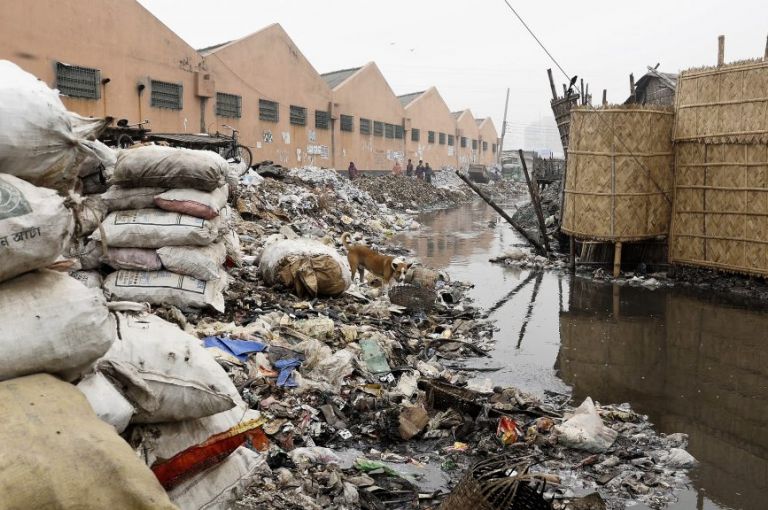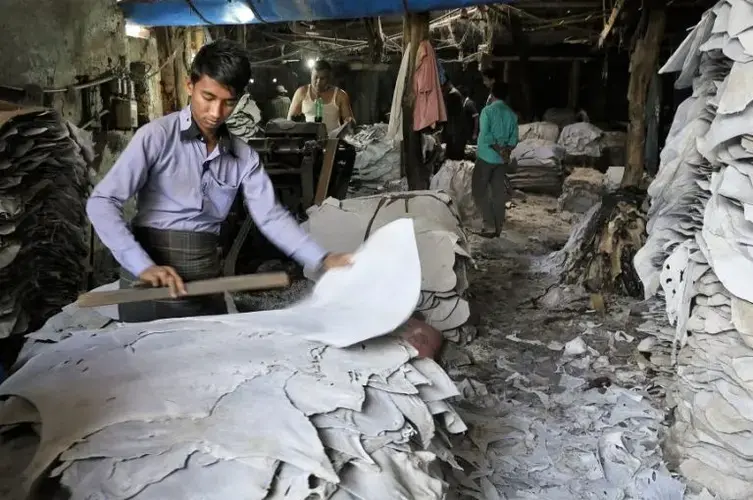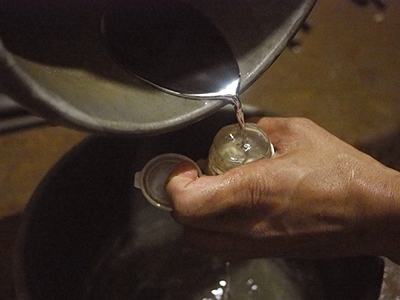
After more than 15 years of ignored high court rulings and inaction, the government in Bangladesh moved against more than 100 tanneries over the weekend by cutting off the leather producers’ electricity and other utilities in the capital’s Hazaribagh neighborhood.
Tanneries in that district were featured in a March 29 PBS NewsHour/Pulitzer Crisis for Crisis Reporting report, “Toxic Business – Inside the Tanneries of Bangladesh.”Journalists Justin Kenny, Larry C. Price and Adam Matthews visited Hazaribagh and found a densely packed residential neighborhood filled with rotting animal hides, garbage, human waste, and untreated tannery wastewater being pumped into neighborhood waterways (you can watch the full report here).
Inside some of the tanneries, the team found children — one as young as 10 years old — working barefoot as they manned machinery and handled animal hides dripping with toxic chemicals. The majority of the workers inside the tanneries visited wore no footwear, gloves, masks or respirators, despite exposure to sulfuric acid (which can cause skin burns, lung fluid buildup and sometimes emphysema), chromium (including one form that has been identified as a carcinogen associated with lung, nasal and sinus cancer) and sodium sulfide (corrosive to the eyes, skin and respiratory tract), among other harmful substances.

Over the weekend, local media reported that the gas, water and electricity connections to the tanneries in Hazaribagh were cut off by the country’s Department of Energy, in keeping with the orders of Bangladesh’s High and Supreme Court.
“The government has not enforced the High Court order since 2001, so the recent steps are welcome, if 16 years overdue,” Richard Pearshouse, a senior researcher with the Health and Human Rights Division of Human Rights Watch, told the NewsHour in an email Monday morning.
The water, gas and electricity cut-offs mark the most significant action taken by Bangladesh’s government since the High Court began ruling against the Hazaribagh tanneries in July of 2001. The judicial body has ruled over the past several years that the tanneries must treat their wastewater, shut down operations in Hazaribagh and relocate to an industrial park on the outskirts of Dhaka. Up until Saturday, however, the neighborhood’s tanneries — more than 150 of them packed into two-square miles — continued to operate with little interference by authorities.

Though some tannery owners have rebuilt operations in the new Savar Tannery Estate, many have been slow to transition because of the cost of moving. Others say the government has been too slow in providing electricity, gas and water connections at the new site.
Bangladesh media reported Monday that the Bangladesh Tanners Association (BTA) will be holding a “black flag” procession through the Hazaribagh tannery district later this week. Hazaribagh’s tanneries have accounted for 90 percent of the nation’s billion-dollar-a-year leather industry. The BTA did not respond to the NewsHour’s request for comment; the association told local media that the government is “destroying” Bangladesh’s leather industry.
It’s still unclear whether the weekend’s actions will close the neighborhood’s tanneries for good. The Bangladesh embassy in Washington did not respond to the NewsHour’s written questions about the government’s actions.
But many activists fear that abuses will continue even if the Hazaribagh shutdown is permanent.
“Relocation won’t fix the widespread problem of hazardous child labor in this industry,” Pearshouse said. “Even the environmental impact won’t diminish if, as we’ve seen in other industries, tanneries dump directly into the river to avoid the marginal costs of treating waste. So the main issue is not the location of the tanneries, it’s whether the government monitors labor and environmental laws on an ongoing basis and rigorously acts on any breaches. If they don’t, then all the government will have done is move the same problems to a new location.”









